By Brian Hibbs
Sometimes you just have to know when to quit.
This week I have sent an email to the customers of our second location, Comix Experience Outpost, that we’ll be closing that location down before the end of the year. Life happened, and we’re losing both of the main employees there at the same time. While we probably could find people and retrain and fully restaff the store, we have big plans for the main store on Divisadero in 2022 that will demand a lot of attention from us and really leaves us very little time to put in to the other, less-profitable, location. I tried to find a buyer for the store, but ultimately all of the leads petered out.
Part of it is me getting older – I had a major heart attack within the last year, and it makes it hard to invest in “starting fresh” again in a secondary location, because that would be a major investment of my and my staff’s time to get it back up to where it needs to be. Part of it is that Divisadero is “my baby”, and Outpost was an already existing store that I bought seven years ago when the former owner (at least the third former owner, at that) declared on Facebook he was going to close the store within two weeks, so I stepped in to save it. However, it’s never been a location that I personally had a lot of emotional investment in.
But even with those barriers, I probably still would have dug in and fought hard for it except for one thing: I’ve lost a great deal of faith in the business of periodical comics and, more specifically, of many of the people in charge of shepherding it. Costs of operation are greatly increasing, profit margins are getting tighter, and the industry as a whole seems hell-bent on catering to speculators and Fear-Of-Missing-Out (FOMO) marketing. And while Divisadero is focused on selling graphic novels, Outpost is primarily about selling periodical comics – I’ve managed to nearly triple the book sales over there from the day I bought it, but it’s still 60% periodicals!
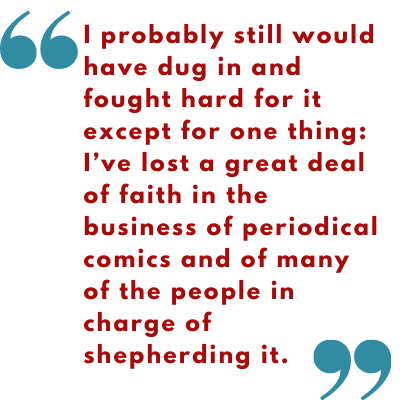
The periodical portion of the business has clearly been shifting strongly over the last few years to lean more heavily on the “collector” side of the market. There are virtually no periodical comics being released today that don’t have at least two covers, and far more than that are becoming increasingly typical. There is at least one publisher who publishes at least ten covers on nearly every single periodical they release, and new publishers just starting are often opening with five-per-issue as their standard. I don’t think these kinds of tactics are even remotely sustainable (especially as distribution is going to continue to fracture for the next year or two), and even if it was, this is in absolutely no way how I am interested in conducting business – especially when we have to now order and rack comics “defensively”, as organized “key comic” apps and groups target the low print runs that collector-focused publishing invariably brings, stripping away supply from the “average reader”.
And even in the face of all of that, I maybe probably coulda kept the second store going, except for the changes in distribution that were initiated by DC, then hammered home by Marvel.
DC moving to Discount Comic Book Service – the #1 competitor for each and every brick and mortar retailer in America – to be their sole distributor under the name “Lunar” was… disheartening. I’ve no interest in enriching my competition! Further, it did absolutely nothing other than increase costs, even if the “work” remains the same of ordering comics, because you have to do it through two different sources (one of which who wasn’t compatible with almost anyone’s computer systems, so new systems and workarounds have to be devised). And just this month DCBS have announced their new discount terms and because we buy our DC graphic novels from Penguin Random House, we’re about to lose 2% on periodical comics as a result (but switching to DCBS for GNs would cost us way more than that because they charge freight, and PRH doesn’t, and when your main location is majority books and books are much much much heavier than periodicals… well, you do the math).

And I fear for the future Diamond. I mean, like a lot. Their service has already markedly worsened in the last three months or so, and when they get the mass exodus of retailers’ Marvel business to PRH in Q4, it is very very hard to see how they’re going to get past that. They’ve failed to modernize their thinking about comics, and it seems unlikely to me that this will result in the loss of margin from DC and Marvel being made up at Diamond – I expect the exact opposite to happen, in fact; I firmly expect our margins to shrink on the “remaining” Diamond-carried publishers.
Now, don’t get me wrong: I still see a future in comics – a long and a strong one for me at least. The Graphic Novel Clubs are growing well, and Divisadero St. has a hell of a team that’s into selling books, and we’re genuinely thriving doing that – but that future has less and less to do with racking and maximizing sales on periodicals without direct buy-in from the publisher in the form of affidavit returnability. (It’s really not viable to do full-copy or strip-cover returns to three different distribution sources because of the costs of labor to handle) But at the new 50% margin on Marvel periodicals, and a soon-to-be 48.5% one on DC for us (after shipping), there’s just not value in risking anything more than the bare minimum for the two largest publishers of periodicals. Just reducing to becoming an effective catalog store for the periodical category becomes the most sensible approach.
All of this drives me crazy because I believe to the depth of my being that the best way to publish comics is to serialize them first because not only do you amortize the creative costs and are able to pay creators what is hopefully a reasonable wage for creation as a Page Rate. (Graphic novels are almost always created with an “advance” on royalties that can amount to below federal minimum wage when compared to the time it takes to write and draw a several hundred-page book – as far as I can tell, advances to comics folks are on the same scale as they are to prose authors, despite comics taking much longer to create. Further, the overwhelming majority of books appear to never earn out those royalties in the first place!) But you also typically gain significantly larger audiences who are willing to try a less expensive serialization than who will buy the completed paperback. Serialization ends up keeping the price of the “final version” of the work cheaper, while at the same time making it more possible for folks to make a living. Only looking at the “best selling” authors gives a radically distorted picture of a what a typical author might be able to earn. And DC and Marvel (at least) periodicals usually sell in the tens of thousands, while the book format collections of the same material typically sell just in the thousands.
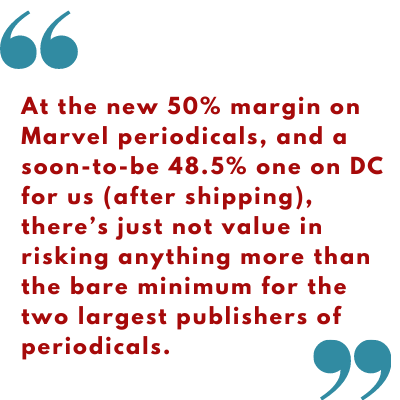
And so San Francisco is going to have 14% fewer comic book stores, in a matter of months.
As hard as this will be, Divisadero St. will be stronger for it, because we won’t have to spend effort doing things that aren’t moving us forward. Just the hours of paperwork, of doing Final Order Cutoff orders each week, and so on, that I will be regaining will mark this as a relief for me. But it’s going to hurt some customers, it’s going to reduce overall access to periodical comics in my city, and those are things that are bitter in my mouth.
But sometimes you just have to know when to quit.
**************************
Brian Hibbs has owned and operated Comix Experience in San Francisco since 1989, was a founding member of the Board of Directors of ComicsPRO, has sat on the Board of the Comic Book Legal Defense Fund, and has been an Eisner Award judge. Feel free to e-mail him with any comments. You can purchase two collections of the first Tilting at Windmills (originally serialized in Comics Retailer magazine) published by IDW Publishing, as well as find an archive of pre-CBR installments right here. Brian is also available to consult for your publishing or retailing program.


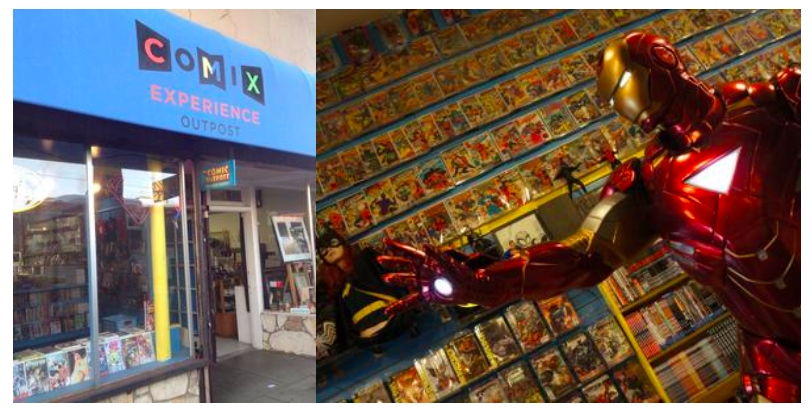
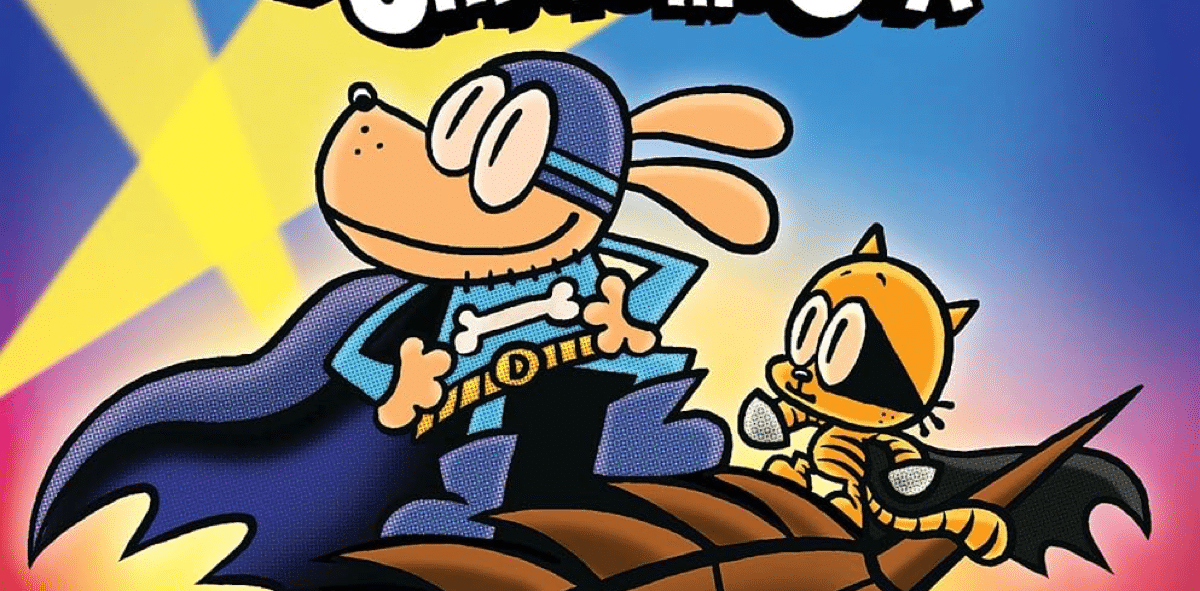
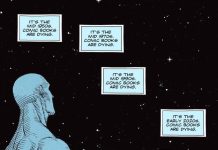




It appears that webcomics will be the way to fund new comic production. Andrews McMeel has the website and an imprint for comic strips. First Second serialized Mermaid on the Hudson. Numerous self publishers selling merchandise online or via Kickstarter.
Otherwise, cartoonists can follow the author route: weekend warrior financed by a 9-5 job until success happens.
I’ve said it before: comics shops must decide if they are a hobby shop or a specialty bookstore. Either is valid, but have different business plans.
Brian, you’ve become a “North Star” for me as a reader and buyer, in determining the kind of shops to invest my consumer dollars in. Thanks for fighting the good fight from a guy in Ohio.
Imagining a future for periodicals that doesn’t involve digital or collectability is of course a losing game. This isn’t terribly insightful. Both of these are key to comics future.
Golden Age retailers wishing for everything to stay the same is now fan fiction.
Torsten the majority of webcomics folks that I am aware of appear to be working for free.
Eggbert, I dont know a single comic book publisher who would tell me that digital periodicals are a significant percentage of sales (outside of edges cases like TWD when the show was hot). And I am for sure a “bronze age” retailer at worst. I am no whereo9ld enough to be “golden age”
Yeah, sad about this but not surprised. I get the impression there is not a lot of young people buying serialized traditional comics, at least not at the rate of replacing the older ones. The last couple of generations have grown up on Manga/YA books. I suspect publishers figured this out a long time ago and have been transitioning to book format comics, where the library and bookstore market dwarfs the direct market and has huge potential for growth, something the direct market is lacking. So serialized comics are for milking the collectors while they are still willing to buy variant covers and other gimmicks, all the while trying to create stories for other media to adapt and use.
There appear to be at least ~50 comics creators with over 750 patrons/$2000 a month on Patreon. Some of them (John Allison) have done print periodical comics (though Wicked Things, his last series, got cancelled due to low sales).
Fifty is great (IT IS!!!!), but there are an easy 7000 comics related SKUs solicited each and every month? I often say there is a fifteen foot high stack of pages of comics release each week… and I suspect I am actually low. Also: $2k/mo isn’t even a viable “roomate” living wage in San Francisco?
-B
Also, as a 7/14 update, we have an agreement in principle with a potential new owner, WHO I THINK WILL BE FANTASTIC, so my hope is now that Outpost will not end up closing altogether. This does not change my assessment of the viability of multi-store operations under the new DC/DCBS and PRH/Marvel terms of sale, or the general danger for the Market As A Whole as we move into 2022 and beyond. Comics retail is at a crucial deflection point for periodical releases, when it should be golden goose that is carrying the entire weight.
Fight me.
-B
When processing “He Said, She Said” stuff, I’d personally always default to the person who has put in the most recent time and treasure and effort. Gary hasn’t worked in a comic book store in at least seven years, and he’d actually sold it twice before I came in and saved the store from oblivion. The ENTIRE landscape has immensely changed in that period (which, was kinda the point of the column)
-B
Every week Image sends a list of the comics releasing that Wednesday. The list this past week had about 16 different titles with 20 more items being just variant covers (also some second printings etc). The majority of issues have at least one variant cover.
Ex: Seven to Eternity 17 – a book I like, no shade to the creators – has 4 different covers to incentivize ordering more copies, up to 25.
Result? As a consumer who is focused on finding stories I like over collecting covers I need to read a longer list to see what my LCS has in. And it could easily confuse a newer reader to the point of throwing up their hands, it’s a lot of work figuring out what you need to buy sometimes.
The consumer has infinite choices today and publishers should be focused on ease of entry/follow above all else.
Also I think I prefer trades in many cases; maybe there should be some kind of pre-order model when something is solicited 6 months before completion with an incentive (signed print?) for putting down a deposit or something (see video game physical copies with collector editions).
Comments are closed.